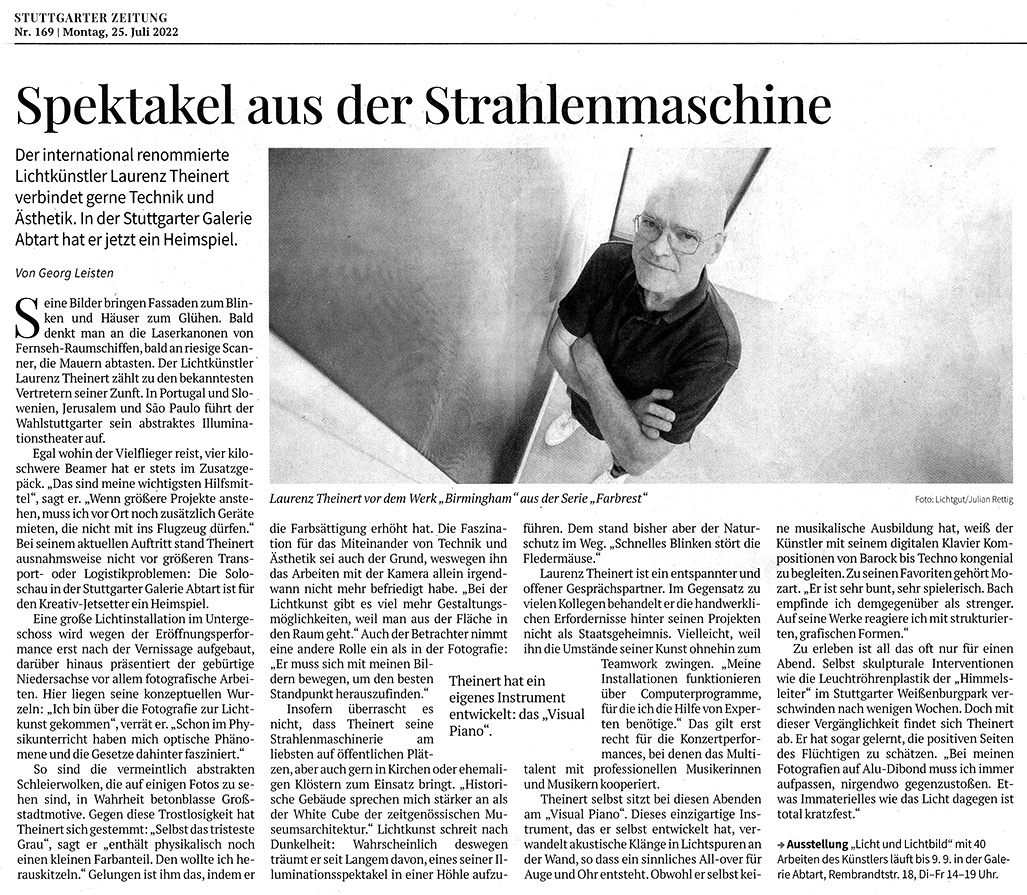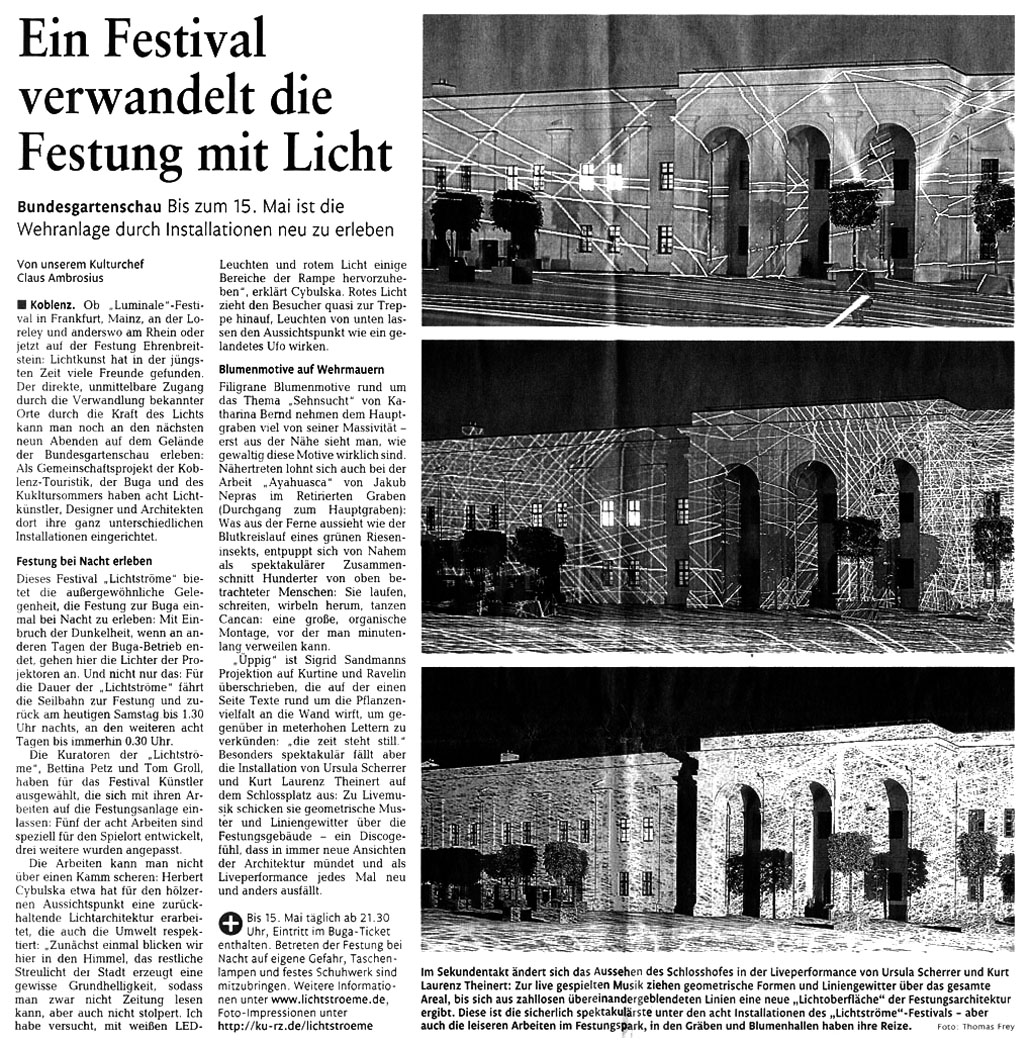




Letztes Brizzeln im Museum
At the weekend, the people of Münster said goodbye to the building at Domplatz
[…] The first farewell act on Friday evening is no less well attended. Curious people crowd around a small podium. They try to find out the secret of Hammerhaus. More or less expertly they exchange views about the mighty sequencer and the almost somewhat inconspicuous visual piano next to it. Shaking heads. Perplexity. Disbelief. Then one of them discovers the laptop, which is somewhat hidden under the instruments: “But everything from the computer!” Not bad reasoning. But the two human components of the audiovisual artist duo Hammerhaus, lighting designer Laurenz Theinert and musician Axel Hanfreich, are hardly as dispensable as this audience member assumes. From the very first moment they cast a spell over the audience in the hall of the Kunstverein. It can hardly help itself, because the 360-degree projection technology makes it part of the spectacle that is being presented here. The soft creaking from the loudspeakers finds its counterpart in jagged, dashed lines on the walls, colored bar patterns fall on the faces of the visitors and the artists. The room and its contents become a work of art: a large machine that produces light. Colors and sounds produced.
Laurenz Theinert strokes the light piano in grand gestures, tracing keys and pedals. Axel Hanfreich pushes buttons, turns and pushes knobs on the sequencer: very sparingly, but very effectively. Minimal beats that invite you to dance alternate with disturbing noise orgies. The result is convincing. It’s a pity that nobody dares to break out into correspondingly ecstatic movements. Sometimes the reverence for contemporary art is perhaps too great. […]
Ruhrnachrichten, 19.04.2009, Sabine Müller, Daniel Grimm
Klingendes Licht
Zehn Jahre Tube: Eine grandiose Geburtstagsperformance
[…] From the outset, “Die Sonografen” aimed at the visual. To the new music of Friedemann Dähn, enriched with drum & bass, psychedelic elements and shock-like sound effects, Kurt Laurenz Theinert throws light on the wall as a 360-degree panorama. Sounds harmless, but it is overwhelming! How beams of white light deform, grid, overlap, become colored, dance, cast nets – all this wonderfully taking up the music, but also leading beyond it – is simply ingenious. The small keyboard with a few controls that accomplishes this was invented by Theinert, and a computer scientist friend supplies the software. Never has the term “light organ” fit as well as here, when Theinert improvises with light on his “visual piano” in real time and without coupling to the musician. […]
Süddeutsche Zeitung, 03.10.2010
Oliver Hochkeppel


hammerhaus
A rustling emerges from the silence. Then a dull knocking. Hesitantly, it turns into a beat, which at first throbs noncommittally, but soon hammers demandingly, carries away loose harmonies and tone sequences and finally finds its way to densely packed rhythm and sound structures. The electronic music of Hammerhaus loves the escalation principle and the combination of club beats with sound structures between ambient and experimental sound art. While Axel Hanfreich is responsible for digital beats and analog loops, Laurenz Theinert operates a visual piano with which he can create and change graphic elements in real time via a keyboard. The images he thus throws on the wall are an integral part of the concept. Hammerhaus’ music is meaningless in a positive sense, referring to nothing but itself, and finds its visual equivalent in the rectangles and lines with which Theinert fills the canvas. The minimalist sounds of Hanfreich sound like impressions from an abstract world that knows no natural sounds, not even diagonals, but only right and left, above and below – as if Mondrian had painted the music. The pieces, which the duo plays in two half-hour sets each, were created from improvisations and continue to give the sound and video artists a lot of freedom. Sometimes Theinert’s graphic realizations complement the soundscape, sometimes they set a counter-rhythm. And Hanfreich proves to be a virtuoso at the sequencer controls, with a penchant for beats that seem to be stuck to the floor, smacking.
Stuttgarter Nachrichten, 14.08.2004
Hochästhetisches Lichtballett
Thus, before the first performance in the small room on the second floor of the museum, which was actually only designed for 30 spectators, the air was thick: there were clear expressions of displeasure, probably also minor scuffles because of the unexpected rush to the performance. It is not surprising that the organizers were surprised by this. When it comes to experimental music from the avant-garde sector, there is usually a yawning void in the local environment. The darkened room was, of course, still oppressively full during the second, half-hour performance. The audience, ranging from old people to children, even sat down on the floor to experience this improvisation of light and music. The initial situation is similar to a planetarium, even if no stars shine on the dome ceiling. But the side walls and ceilings of the rectangular room serve as a projection surface for Kurt Theinert’s light sculpture, who sits in the center of the room behind a small electronic keyboard instrument, which he christens “Visual Piano. In a compartment below lies a laptop, on the floor are pedals such as those used by electric guitarists to control volume. Across from him sits Scott Roller with a classical cello, which he discreetly amplifies. A small effect device, a so-called delay, allows him to record what he plays and immediately let it run again, which can go on endlessly until he deletes the tracks again. He also uses this delay sparingly, perhaps producing a crackling cluster carpet or a small bass accompaniment figure. The majority, however, he plays spontaneously without machine support. This is one of the reasons why an extremely high dynamic unfolds here. Visually, the Visual Piano, which controls four projectors, can cover all extremes between point and surface with the basic elements of light mosaic tiles and line by controlling light intensity, expansion, color and position: The impression ranges from chaotic starry firmament to geometric architectural sketches to fabrics and lush light wallpaper. After years of practice, the light artist has mastered his instrument with virtuosity, conjuring up crystal interior views that quickly change into top views, designing bizarre temple complexes that grow and deform in a computer-generated manner until Theinert wipes them away. Lightning-like light storms descend as well as leisurely evolving paintings, always in duet with the freely improvising, excellent cellist who oscillates between euphony and sound experimentation. The direction of inspiration is open. Both improvisers are initiators as well as reactors and thus create a highly aesthetic light ballet that provokes incessant astonishment.
Sindelfinger Zeitung, 15.03.2011
Bernd Heiden
